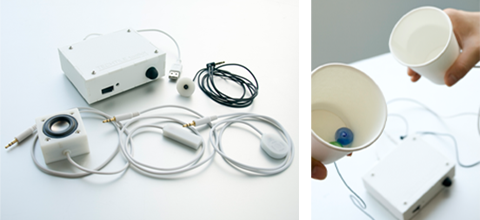2012/6/12 EuroHaptics2012
TECHTILE toolkit: Haptic design environment for sharing haptic experience Half-day Workshop
Tuesday, June 12, 2012, Scandic Rosendahl hotel
-
http://www.eurohaptics2012.org/workshops.html
Organizers
Masashi Nakatani, Yasuaki Kakehi, Kouta Minamizawa, Soichiro Mihara+YCAM InterLab
Workshop theme and goals
The objective of this half-day workshop is to familiarize the audiences with the recent advances in haptics research and its future perspective in designing haptic stimuli including artistic expression of the touch. In this workshop, four lecturers, including contemporary art professionals and researchers in haptics will give presentations on how haptic information can be experienced through our developed haptics toolkit.
Enormous haptic devices have been developed so far. Most of those haptic devices are utilized for practical applications such as surgical robotics and information displays for blind people, and these are actively studied around the world. Novel actuators and sensors have been also developed using up-to-date technology to be applied to tactile devices. Emerging haptics research fields, such as haptic rendering which studies the method of how haptic display could be manipulated, are presenting various tactile sensations such as hardness, roughness and stickiness.
Although the outcome of haptics research is highly expected to be utilized to various applications, the outcome of haptic research cannot be easily applied to practical use in industry in a straight forward manner. This would be because people outside haptics research community usually have little knowledge on the sense of touch, and therefore it would be difficult to imagine what kinds of applications could be possible with haptics. While some workshops on haptics have been organized aiming to apply research findings in haptics to industry, most of the workshops were mainly successful in teaching the basic knowledge of haptics and not in presenting the practical ways of its applications. In addition, haptic devices are generally expensive and decent programming skills are required to drive these devices, which makes it difficult for people outside haptic research to immediately utilize the cutting-edge haptic research outcomes in their practical usages.
Therefore, it would be attractive to the potential users of haptics if an easy-to-handle haptic device would be developed. In order to achieve this goal, we have developed a novel trial haptics device called “TECHTILE toolkit” (see Figure 1). This toolkit enables users to create haptic stimuli without any professional knowledge in haptics. People who are new to TECHTILE toolkit should be able to learn how to use it within several minutes, and they can test what kinds of haptic stimuli would be possible in conveying the sense of touch. Users can record various tactile stimuli with this toolkit, and also can share the tactile stimuli with others via Internet. This toolkit is easy to develop by users inexpensively without any professional technical skills. Current prototype of TECHTILE toolkit is composed of haptic recorder (a microphone), haptic display (small vibrators), and signal amplifier that is optimized to present not only zone of audibility (20-20000Hz) but also low frequency (1-20Hz) vibration. We have been holding a number of workshops in the universities and art museums in Japan, in order to promote this device as an introductory educational tool for promoting the possibility of haptic design and its applications.
In the workshop, participants will experience our developed TECHTILE toolkit to understand what could be possible in designing haptic stimuli. This workshop will also involve a constructive discussion on the future prospects and haptic technologies with the participants. This workshop should attract interests from most audience who are seeking the way to apply the outcome of haptics research in their fields. And their experiences in this workshop should lead to creative uses of haptics in the industries, and it may be helpful for raising research funds for the haptic research from industry, which will connect haptics research fields with another research communities.
* “TECHTILE”, a compound term by combining “TECHnology” with “tacTILE” perception/expression, has been a key topic of the study. The TECHTILE committee was launched by Masashi Nakatani and Yasuaki Kakehi and other members, and the committee has been hosted public exhibitions on latest haptic technology in Japan since 2007.

Figure 1 TECHTILE toolkit (left) and the example use of the toolkit
to convey the feeling of rolling glass balls in empty cup (right).
Outcomes of the workshop
At the end of this workshop, we expect that participants will:
• Experience what will be possible with haptic devices
• Have learned about strategies for examining haptics expression in design and contemporary art
• Participate actively in small group workshops to conduct trial-and-error on their haptic expressions
• Have access to useful haptics sharing resources (software, YouTube page for tactile sharing)
Relevance to the field
• Haptic design
• Prototyping haptic interactions for haptic application in design and art field
• Teaching Haptics
Intended audience
The workshop will be of general interest to industrial researchers who develop haptic devices, designers, artist and educators who are not familiar with haptics but who wish to establish haptic design and possible applications. Instructors who are interested in developing a course on haptics are also welcomed audience.
Expected number and selection of participants
Thirty participants for the workshop is maximum, but for audit, additional twenty participants will be available.
Program and Schedule
1: What is TECHnology based tacTILE design (TECHTILE)?10 min
2: Principle of haptic perception and haptic expression10 min
3: Icebreak: how do you express this haptic feeling?30 min
4: Instruction on TECHTILE Toolkit10 min
5: Workshop on Haptic recording with TECHTILE Toolkit60 min
6: Presentation30 min
7: Discussion on haptic experience and future technologies30 min
Organizers’ names and backgrounds
Masashi Nakatani (Keio University)
JSPS Superlative Postdoctral Fellow
Graduate school of System Design and Management
Keio University
Yokohama, Japan
—
Yasuaki Kakehi (Keio University)
Associate Professor
Faculty of Environment and Information Studies
Keio University Shonan Fujisawa Campus
Yokohama, Japan
http://www.xlab.sfc.keio.ac.jp/
—
Kouta Minamizawa (Keio University)
Assistant Professor
Graduate School of Media Design
Keio University
Yokohama, Japan
http://minamizawa.jp/
—
Soichiro Mihara (Yamaguchi Center for Art and Media [YCAM])
Artist
Yamaguchi Center for Art and Media (YCAM), InterLab
Yamaguchi, Japan
http://mhrs.jp/
—
Collaborators
JST-CREST Haptic Media Project
-
Contact Information
Masashi Nakatani
Graduate School of Media Design, Keio University
nakatani@tachilab.org
-
Soicihiro Mihara
InterLab, Yamaguchi Center for Art and Media [YCAM]
mhrs@ycam.jp















